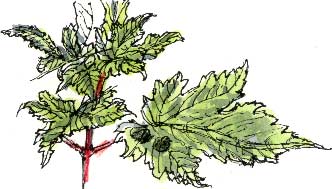 THIS
SYCAMORE sapling was growing in the smallest strip of soil at the edge of a
hospital car park in the city. Given time, I’m sure it would grow, spread
its ‘helicopter’ winged
seeds and turn tarmac into woodland. The black blotches on the leaf are Tar
Spot fungus, Rhytisma acerinum, which can infect a wide variety
of maples. The fungus overwinters on fallen leaves, then windblown spores infect
young
foliage the following spring. Tar Spot prefers damp conditions so the floods
we had in Wakefield 100 days ago must have suited it.
THIS
SYCAMORE sapling was growing in the smallest strip of soil at the edge of a
hospital car park in the city. Given time, I’m sure it would grow, spread
its ‘helicopter’ winged
seeds and turn tarmac into woodland. The black blotches on the leaf are Tar
Spot fungus, Rhytisma acerinum, which can infect a wide variety
of maples. The fungus overwinters on fallen leaves, then windblown spores infect
young
foliage the following spring. Tar Spot prefers damp conditions so the floods
we had in Wakefield 100 days ago must have suited it.
The treatment for this fungus is Bordeaux Mixture which contains
copper sulphate. Sulphur dioxide in the air in cities also eradicates it so
the fact
that Tar Spot is a common sight could be seen as an encouraging sign that
the air in Wakefield these days is reasonably clean.
Autumn Influx
 Cooler
days and nights mean that insects are less plentiful in the wood and we’re
noticing more birds coming into the garden. We had long-tailed tits in the
rowan in the front garden this morning and on the back lawn there were four
blackbirds, apparently all getting along together, which wasn’t the case
during the nesting season.
Cooler
days and nights mean that insects are less plentiful in the wood and we’re
noticing more birds coming into the garden. We had long-tailed tits in the
rowan in the front garden this morning and on the back lawn there were four
blackbirds, apparently all getting along together, which wasn’t the case
during the nesting season.
 The
blackbird population is boosted at this time of year not only because this
year's young are now spreading their wings but
also because migrant blackbirds come across the North Sea to escape the colder
continental winters. Despite milder winters there still appears to be an influx
of blackbirds at this time of year.
The
blackbird population is boosted at this time of year not only because this
year's young are now spreading their wings but
also because migrant blackbirds come across the North Sea to escape the colder
continental winters. Despite milder winters there still appears to be an influx
of blackbirds at this time of year.
Well, there’s a bit of an influx in
our back garden anyway, but that is, after all, a part of the bigger picture.
 THIS
SYCAMORE sapling was growing in the smallest strip of soil at the edge of a
hospital car park in the city. Given time, I’m sure it would grow, spread
its ‘helicopter’ winged
seeds and turn tarmac into woodland. The black blotches on the leaf are Tar
Spot fungus, Rhytisma acerinum, which can infect a wide variety
of maples. The fungus overwinters on fallen leaves, then windblown spores infect
young
foliage the following spring. Tar Spot prefers damp conditions so the floods
we had in Wakefield 100 days ago must have suited it.
THIS
SYCAMORE sapling was growing in the smallest strip of soil at the edge of a
hospital car park in the city. Given time, I’m sure it would grow, spread
its ‘helicopter’ winged
seeds and turn tarmac into woodland. The black blotches on the leaf are Tar
Spot fungus, Rhytisma acerinum, which can infect a wide variety
of maples. The fungus overwinters on fallen leaves, then windblown spores infect
young
foliage the following spring. Tar Spot prefers damp conditions so the floods
we had in Wakefield 100 days ago must have suited it. Cooler
days and nights mean that insects are less plentiful in the wood and we’re
noticing more birds coming into the garden. We had long-tailed tits in the
rowan in the front garden this morning and on the back lawn there were four
blackbirds, apparently all getting along together, which wasn’t the case
during the nesting season.
Cooler
days and nights mean that insects are less plentiful in the wood and we’re
noticing more birds coming into the garden. We had long-tailed tits in the
rowan in the front garden this morning and on the back lawn there were four
blackbirds, apparently all getting along together, which wasn’t the case
during the nesting season. The
blackbird population is boosted at this time of year not only because this
year's young are now spreading their wings but
also because migrant blackbirds come across the North Sea to escape the colder
continental winters. Despite milder winters there still appears to be an influx
of blackbirds at this time of year.
The
blackbird population is boosted at this time of year not only because this
year's young are now spreading their wings but
also because migrant blackbirds come across the North Sea to escape the colder
continental winters. Despite milder winters there still appears to be an influx
of blackbirds at this time of year.